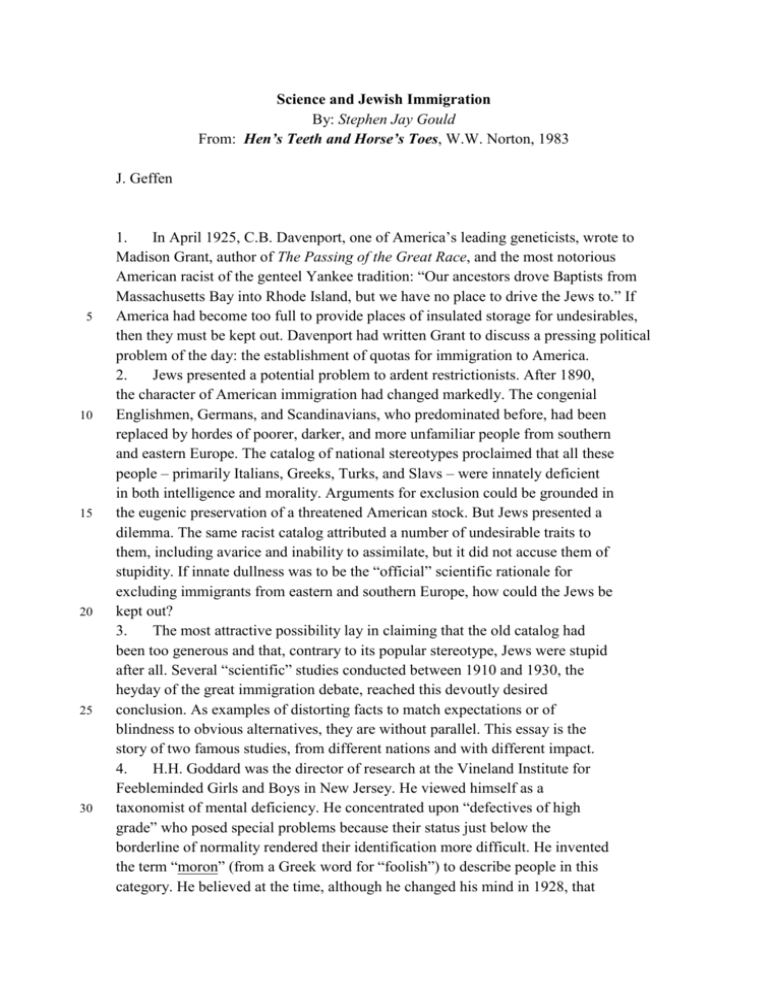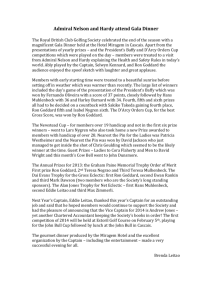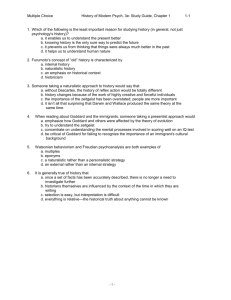J. Geffen
advertisement

Science and Jewish Immigration By: Stephen Jay Gould From: Hen’s Teeth and Horse’s Toes, W.W. Norton, 1983 J. Geffen 5 10 15 20 25 30 1. In April 1925, C.B. Davenport, one of America’s leading geneticists, wrote to Madison Grant, author of The Passing of the Great Race, and the most notorious American racist of the genteel Yankee tradition: “Our ancestors drove Baptists from Massachusetts Bay into Rhode Island, but we have no place to drive the Jews to.” If America had become too full to provide places of insulated storage for undesirables, then they must be kept out. Davenport had written Grant to discuss a pressing political problem of the day: the establishment of quotas for immigration to America. 2. Jews presented a potential problem to ardent restrictionists. After 1890, the character of American immigration had changed markedly. The congenial Englishmen, Germans, and Scandinavians, who predominated before, had been replaced by hordes of poorer, darker, and more unfamiliar people from southern and eastern Europe. The catalog of national stereotypes proclaimed that all these people – primarily Italians, Greeks, Turks, and Slavs – were innately deficient in both intelligence and morality. Arguments for exclusion could be grounded in the eugenic preservation of a threatened American stock. But Jews presented a dilemma. The same racist catalog attributed a number of undesirable traits to them, including avarice and inability to assimilate, but it did not accuse them of stupidity. If innate dullness was to be the “official” scientific rationale for excluding immigrants from eastern and southern Europe, how could the Jews be kept out? 3. The most attractive possibility lay in claiming that the old catalog had been too generous and that, contrary to its popular stereotype, Jews were stupid after all. Several “scientific” studies conducted between 1910 and 1930, the heyday of the great immigration debate, reached this devoutly desired conclusion. As examples of distorting facts to match expectations or of blindness to obvious alternatives, they are without parallel. This essay is the story of two famous studies, from different nations and with different impact. 4. H.H. Goddard was the director of research at the Vineland Institute for Feebleminded Girls and Boys in New Jersey. He viewed himself as a taxonomist of mental deficiency. He concentrated upon “defectives of high grade” who posed special problems because their status just below the borderline of normality rendered their identification more difficult. He invented the term “moron” (from a Greek word for “foolish”) to describe people in this category. He believed at the time, although he changed his mind in 1928, that Hen’s Teeth and Horse’s Toes / 2 35 40 45 50 55 60 65 70 most morons should be confined to institutions for life, kept happy with tasks apportioned to their ability, and above all, prevented from breeding. 5. Goddard’s general method for identifying morons was simplicity itself. Once you had enough familiarity with the beast, you simply looked at one, asked a few questions, and drew your evident conclusions. If they were dead, you asked questions of the living who knew them. If they were dead, or even fictitious, you just looked. Goddard once attacked the poet Edwin Markham for suggesting that “The Man with the Hoe”, inspired by Millet’s famous painting of a peasant, “came to his condition as the result of social conditions which held him down and made him like the clods that he turned over”. Couldn’t Markham see that Millet’s man was mentally deficient? “The painting is a perfect picture of an imbecile”, Goddard remarked. Goddard thought he had a pretty good eye himself, but the main task of identifying morons must be given to women because nature had endowed the fair sex with superior intuition: After a person has had considerable experience in this work, he almost gets a sense of what a feeble-minded person is so that he can tell one afar off. The people who are best at this work, and who I believe should do this work, are women. Women seem to have closer observation than men 6. In 1912, Goddard was invited by the U.S. Public Health Service to try his skill at identifying morons among arriving immigrants on Ellis Island. Perhaps they could be screened out and sent back, thus reducing the “menace of the feebleminded”. But this time, Goddard brought a new method to supplement his identifications by sight – the Binet tests of intelligence, later to become (at the hands of Lewis M. Terman of Stanford University), the Stanford-Binet scale, or the conventional measure of IQ. Binet had just died in France and would never witness the distortion of his device for identifying children who needed special help in school into an instrument for labeling people with a permanent stamp of inferiority. 7. Goddard was so encouraged by the success of his preliminary trials that he raised some money and sent two of his women back to Ellis Island in 1913 for a more thorough study. In two and a half months, they tested four major groups; thirty-five Jews, twenty-two Hungarians, fifty Italians, and forty-five Russians. The Binet tests produced an astounding result: 83 percent of the Jews, 87 percent of the Russians, 80 percent of the Hungarians, and 79 percent of the Italians were feebleminded – that is, below mental age twelve (the upper limit of moronity by Goddard’s definition). Goddard himself was a bit embarrassed by his own exaggerated success. Weren’t his results too good to be true? Could people be made to believe that four-fifths of any nation were morons? Goddard played with the numbers a bit, and got his figures down to 40 or 50 percent, but he was still perturbed. Hen’s Teeth and Horse’s Toes / 3 75 80 85 90 95 100 105 110 8. The Jewish sample attracted his greatest interest for two reasons. First, it might resolve the dilemma of the supposedly intelligent Jew and provide a rationale for keeping this undesirable group out. Second, Goddard felt that he could not be accused of bias for the Jewish sample. The other groups had been tested via interpreters, but he had a Yiddish-speaking psychologist for the Jews. 9. In retrospect, Goddard’s conclusions were far more absurd than even he allowed himself to suspect in anxious moments. It became clear, a few years later, that Goddard had constructed a particularly harsh version of the Binet tests. His scores stood well below the rankings produced by all other editions. Fully half the people who scored in the low, but normal, range of the StanfordBinet scale tested as morons on Goddard’s scales. 10. But the greater absurdity arose from Goddard’s extraordinary insensitivity to environmental effects, both long-term and immediate, upon test scores. In his view, the Binet tests measured innate intelligence by definition, since they required no reading or writing and made no explicit reference to particular aspects of particular cultures. Caught in this vicious circle of argument, Goddard became blind to the primary reality that surrounded his women on Ellis Island. The redoubtable Ms. Kite approaches a group of frightened men and women – mostly illiterate, few with any knowledge of English, all just off the boat after a grueling journey in steerage – plucks them from the line and asks them to name as many objects as they can, in their own language, within three minutes. Could their poor performance reflect fear, befuddlement, or physical weakness rather than stupidity? Goddard considered the possibility, but rejected it: What shall we say of the fact that only 45 percent can give sixty words in three minutes, when normal children of 11 years sometimes give 200 words in that time! It is hard to find an explanation except lack of intelligence …. How could a person live even 15 years in any environment without learning hundreds of names of which he could certainly think of 60 in three minutes. 11. Could their failure to identify the date, or even the year, be attributed to anything other than moronity? Must we again conclude that the European peasant of the type that immigrates to America pays no attention to the passage of time? That the drudgery of life is so severe that he cares not whether it is January or July, whether it is 1912 or 1906? Is it possible that the person may be of considerable intelligence and yet, because of the peculiarity of his environment, not have acquired this ordinary bit of knowledge, even though the calendar is not in general use on the continent, or is somewhat complicated as in Russia? If so what an environment it must have been! Hen’s Teeth and Horse’s Toes / 4 115 120 125 130 135 140 145 150 155 12. Goddard wrestled with the issue of this moronic flood. On the one hand, he could see some benefits: They do a great deal of work that no one else will do…. There is an immense amount of drudgery to be done, an immense amount of work for which we do not wish to pay enough to secure more intelligent workers…. May it be that possibly the moron has his place. 13. But he feared genetic deterioration even more and eventually rejoiced in the tightening of standards that his program had encouraged. In 1917 he reported with pleasure that deportations for mental deficiency had increased by 350 percent in 1913 and 570 percent in 1914 over the average for five preceding years. Morons could be identified at ports of entry and shipped back, but such an inefficient and expensive procedure could never be instituted as general policy. Would it not be better simply to restrict immigration from nations teeming with morons? Goddard suggested that his conclusions “furnish important considerations for future actions both scientific and social as well as legislative”. Within ten years, restriction based upon national quotas had become a reality. 14. Meanwhile, in England, Karl Pearson had also decided to study the apparent anomaly of Jewish intelligence. Pearson’s study was as ridiculous as Goddard’s, but we cannot attribute its errors (as we might, being unreasonably charitable, in Goddard’s case) to mathematical naïveté, for Pearson virtually invented the science of statistics. Pearson, the first Galton Professor of Eugenics at University College, London, founded the Annals of Eugenics in 1925. He chose to initiate the first issue with his study of Jewish immigration, apparently regarding it as a model of sober science and rational social planning. He stated his purpose forthrightly in the opening lines: The purport of this memoir is to discuss whether it is desirable in an already crowded country like Great Britain to permit indiscriminate immigration, or, if the conclusion be that it is not, on what ground discrimination could be based. 15. If a group generally regarded as intellectually able could be ranked as inferior, then the basic argument for restriction would be greatly enhanced, for who would then defend the groups that everyone considered as stupid? Pearson, however, loudly decried any attempt to attribute motive or prior prejudice to his study. One can only recall Shakespeare’s line, “The lady doth protest too much, methinks”. There is only one solution to a problem of this kind, and it lies in the cold light of statistical inquiry…. We have no axes to grind, we have no governing body to propitiate by well advertised discoveries; we are paid by nobody to reach results of a given bias. We have no electors, no subscribers to encounter in the market place. We firmly believe that we Hen’s Teeth and Horse’s Toes / 5 160 165 170 175 180 185 190 195 have no political, no religious and no social prejudices…. We rejoice in numbers and figures for their own sake and, subject to human fallibility, collect our data – as all scientists must do – to find out the truth that is in them. 16. Pearson measured everything he imagined might be important in assessing “worthiness”. He established four categories for cleanliness of hair: very clean and tidy, clean on the whole, dirty and untidy, and matted or verminous. He assessed both inner and outer clothing on a similar scale: clean, a little dirty, dirty, and filthy. He then computed correlation coefficients between all measures and was generally disappointed by the low values obtained. He could not understand, for example, why cleanliness of body and hair correlated only .2615 in boys and .2119 in girls, and mused: We should naturally have supposed that cleanliness of body and tidiness of hair would be products of maternal environment and so highly correlated. It is singular that they are not. There may be mothers who consider chiefly externals, and so press for tidiness of hair, but it is hard to imagine that those who emphasize cleanliness of body overlook cleanliness of hair. 17. Pearson concluded his study of physical measures by proclaiming Jewish children inferior to the native stock in height, weight, susceptibility to disease, nutrition, visual acuity, and cleanliness: Jewish alien children are not superior to the native Gentile. Indeed, taken all round we should not be exaggerating if we asserted that they were inferior in the great bulk of the categories dealt with. 18. The only possible justification for admitting them lay in potentially superior intelligence to overbalance their physical shortcomings. Pearson therefore studied intelligence by the same type of short and subjective scale that had characterized his measures of physical traits. For intelligence, he relied upon teachers’ judgments rated from A to G. Computing the raw averages, he found that Jewish children were not superior to native Gentiles. Jewish boys ranked a bit higher, but the girls scored notably lower than their English classmates. Pearson concluded, with a striking analogy: Taken on the average, and regarding both sexes, this alien Jewish population is somewhat inferior physically and mentally to the native population…. We know and admit that some of the children of these alien Jews from the academic standpoint have done brilliantly; whether they have the staying power of the native race is another question. No breeder of cattle, however, would purchase an entire herd because he anticipated finding one or two fine specimens included in it; still less would he do it, if his byres and pastures were already full. Hen’s Teeth and Horse’s Toes / 6 200 205 210 215 220 225 230 235 19. But Pearson realized that he was missing one crucial argument. He had already admitted that Jews lived in relative poverty. Suppose intelligence is more a product of environment than inborn worth? Might not the average scores of Jews reflect their disadvantaged lives? Would they not be superior after all if they lived as well as the native English? Pearson recognized that he had to demonstrate the innateness of intelligence to carry his argument for restricted immigration based on irremediable mediocrity. 20. He turned again to his correlation coefficients. If low intelligence correlated with measures of misery (disease, squalor, and low income, for example), then an environmental basis might be claimed. But if few or no correlations could be found, then intelligence is not affected by environment and must be innate. Pearson computed his correlation coefficients and, as with the physical measures, found very few high values. But this time he was pleased. The correlations produced little beyond the discovery that intelligent children sleep less and tend to breathe more through their nose! He concluded triumphantly: There does not exist in the present material any correlation of the slightest consequence between the intelligence of the child and its physique, its health, its parents’ care or the economic and sanitary conditions of its home…. Intelligence as distinct from mere knowledge stands out as a congenital character. Let us admit finally that the mind of man is for the most part a congenital product, and the factors which determine it are racial and familial…. Our material provides no evidence that a lessening of the aliens’ poverty, an improvement in their food, or an advance in their cleanliness will substantially alter their average grade of intelligence… It is proper to judge the immigrant by what he is as he arrives, and reject or accept him then. 21. But conclusions based upon negative evidence are always suspect. Pearson’s failure to record correlations between “intelligence” and environment might suggest the true absence of any relationship. But it might also simply mean that his measures were as lousy as the hair in his category 4. Maybe a teacher’s assessment doesn’t record anything accurately, and its failure to correlate with measures of environment only demonstrates its inadequacy as an index of intelligence. After all, Pearson had already admitted that correlations between physical measures had been disappointingly small. He was too good a statistician to ignore this possibility. So he faced it and dismissed it with one of the worst arguments I have ever read. 22. Pearson gave three reasons for sticking to his claim that intelligence is innate. The first two are irrelevant: teachers’ assessments correlate with Binet test scores, and high correlations between siblings and between parents and children also prove the innateness of intelligence. But Pearson had not given Hen’s Teeth and Horse’s Toes / 7 240 245 250 255 260 265 270 275 Binet tests to the Jewish children and had not measured their parents’ intelligence in any way. These two claims referred to other studies and could not be transferred to the present case. Pearson appreciated this weakness and therefore advanced a third argument based upon internal evidence: intelligence (teachers’ assessment) failed to correlate with environment but it did correlate with other “independent” measures of mental worth. 23. But what were these other independent measures? Believe it or not, Pearson chose “conscientiousness” (also based on teachers’ assessments and scored as keen, medium, and dull), and rank in class. How else does a teacher assess “intelligence” if not (in large part) by conscientiousness and rank in class? Pearson’s three measures – intelligence, conscientiousness, and rank in class – were redundant assessments of the same thing: the teacher’s opinion of their students’ worth. But we cannot tell whether these opinions record inborn capacities, environmental advantages, or teachers’ prejudices. In any case, Pearson concluded with an appeal to bar all but the most intelligent of foreign Jews: For men with no special ability – above all for such men as religion, social habits, or language keep as a caste apart, there should be no place. They will not be absorbed by, and at the same time strengthen the existing population; they will develop into a parasitic race. 24. Goddard’s and Pearson’s studies shared the property of internal contradictions and evident prejudice sufficient to dismiss all claims. But they differed in one important respect: social impact. Britain did not enact laws to restrict immigration by racial or national origin. But in America, Goddard and his colleagues won. Goddard’s work on Ellis Island had already encouraged immigration officials to reject people for supposed moronity. Five years later, the army tested 1.75 million World War I recruits with a set of examinations that Goddard helped write and that were composed by a committee meeting at his Vineland Training School. The tabulations did not identify Jews per se but calculated “innate intelligence” by national averages. These absurd tests, which measured linguistic and cultural familiarity with American ways (see my book, The Mismeasure of Man, W.W. Norton, 1981), ranked recent immigrants from southern and eastern Europe well below the English, Germans, and Scandinavians who had arrived long before. The average soldier of most southern and eastern European nations scored as a moron on the army tests. Since most Jewish immigrants arrived from eastern European nations, quotas based on country of origin eliminated Jews as surely as collegiate quotas based on geographical distribution once barred them from elite campuses. 25. When quotas were set for the Immigration Restriction Act of 1924, they were initially calculated at 2 percent of people from each nation present in America at the census of 1890, not at the most recent count of 1920. Since few Hen’s Teeth and Horse’s Toes / 8 280 285 290 southern and eastern Europeans had arrived by 1890, these quotas effectively reduced the influx of Slavs, Italians, and Jews to a trickle. Restriction was in the air and would have occurred anyway. But the peculiar character and intent of the 1924 quotas were largely a result of propaganda issued by Goddard and his eugenical colleagues. 26. What effect did the quotas have in retrospect? Allan Chase, author of The Legacy of Malthus, the finest book on the history of scientific racism in America, has estimated that the quotas barred up to six million southern, central, and eastern Europeans between 1924 and the outbreak of World War II (assuming that immigration had continued at its pre-1924 rate). We know what happened to many who wanted to leave but had no place to go. The pathways to destruction are often indirect, but ideas can be agents as surely as guns and bombs. Hen’s Teeth and Horse’s Toes / 9 Questions should be answered in your own words, in English, unless otherwise indicated. 1. 2. 3. 4. 5. What made it more difficult for American racists to exclude Jewish immigrants? Answer: _______________________________________________________________ _______________________________________________________________ _______________________________________________________________ _______________________________________________________________ Answer the question below in English. What “scientific” studies were undertaken in order to confirm and support racist prejudices (paragraphs 1-3). Answer: _______________________________________________________________ _______________________________________________________________ _______________________________________________________________ _______________________________________________________________ Answer the question below in Hebrew. What made the definition of a moron such a difficult problem? Answer: _______________________________________________________________ _______________________________________________________________ _______________________________________________________________ _______________________________________________________________ Answer the question below in English. On the treatment of morons – paragraph 4 – Goddard seems to have undergone a change of heart; describe. Answer: _______________________________________________________________ _______________________________________________________________ _______________________________________________________________ _______________________________________________________________ Answer the question below in Hebrew. Goddard’s attack on Markham probably reflects serious disagreements on essential social values; which ones Answer: _______________________________________________________________ _______________________________________________________________ _______________________________________________________________ _______________________________________________________________ _______________________________________________________________ Hen’s Teeth and Horse’s Toes / 10 6. 7. 8. 9. 10. 11. Answer the question below in English. How could Goddard – paragraphs 7-8 – have defended himself against a charge of anti-Jewish prejudice? Answer: _______________________________________________________________ _______________________________________________________________ _______________________________________________________________ Answer the question below in English. What elements, which most probably accounted for the immigrants’ poor performances in the tests, did Goddard disregard? Answer: _______________________________________________________________ _______________________________________________________________ _______________________________________________________________ Answer the question below in English. What, according to Goddard, was the benefit American society – paragraphs 11-12 – likely to derive from the arrival of those moronic immigrants? Answer: _______________________________________________________________ _______________________________________________________________ _______________________________________________________________ Answer the question below in Hebrew. What threatening development did Goddard envisage if the immigration of those so-called morons was not restricted? Answer: _______________________________________________________________ _______________________________________________________________ _______________________________________________________________ Answer the question below in English. Paragraph 7 would suggest that Goddard was guilty of one practice that, theoretically, is utterly unacceptable in scientific work; which one? Answer: _______________________________________________________________ _______________________________________________________________ _______________________________________________________________ Answer the question below in English. At what point did Goddard himself start doubting the validity of his work? Answer: _______________________________________________________________ _______________________________________________________________ Hen’s Teeth and Horse’s Toes / 11 12. 13. 14. 15. 16. 17. _______________________________________________________________ Answer the question below in English. How did Goddard’s work affect the attitude and practices adopted by the immigration authorities? Answer: _______________________________________________________________ _______________________________________________________________ _______________________________________________________________ _______________________________________________________________ Answer the question below in English. Why did Pearson – paragraphs 14-16 – decide to make Jewish immigration the first object of his study? Answer: _______________________________________________________________ _______________________________________________________________ _______________________________________________________________ Answer the question below in English. If “worthiness”, as suggested by Pearson, were indeed one criterion, then one particular fact – paragraph 18 – could have upset Pearson’s thesis; which one? Answer: _______________________________________________________________ _______________________________________________________________ Answer the question below in English. What quality possessed by a native Englishman could offset his shortcomings when competing with a brilliant Jew? Answer: _______________________________________________________________ _______________________________________________________________ _______________________________________________________________ Answer the question below in English. What thesis – paragraphs 19-20 – would have made Pearson’s findings obviously inadmissible? Answer: _______________________________________________________________ _______________________________________________________________ _______________________________________________________________ Answer the question below in English. What was the real purpose of Pearson’s study as described in paragraph 21? Answer: Hen’s Teeth and Horse’s Toes / 12 _______________________________________________________________ _______________________________________________________________ _______________________________________________________________ Answer the question below in Hebrew. 18. Why shouldn’t the teacher’s assessment of the student’s intelligence – paragraph 21 – be taken at face value? Answer: _______________________________________________________________ _______________________________________________________________ _______________________________________________________________ Choose the best answer. 19. All the arguments put forth by Pearson to prove that the students he had tested were rather dull – paragraphs 21 – 23 – should perhaps be discounted because One. he failed to take the teachers’ opinions into account. Two. the statistical sample was much too large. Three. he relied on entirely objective criteria. Four. they are based on the impressions of teachers who could have been swayed by matters irrelevant to the issue at hand. Answer the question below in English. 20. What serious advantage did Goddard’s tests provide those immigrants of English, German, or Scandinavian origin – paragraph 24 – over those coming from Southern or Eastern Europe? Answer: _______________________________________________________________ _______________________________________________________________ _______________________________________________________________ Answer the question below in Hebrew. 21. How did Pearson’s and Goddard’s studies affect the immigration policies of their respective governments? Answer: One. Pearson: _______________________________________________________ _______________________________________________________________ _______________________________________________________________ _______________________________________________________________ _______________________________________________________________ b. Goddard: ____________________________________________________ _______________________________________________________________ _______________________________________________________________ _______________________________________________________________ _______________________________________________________________ Hen’s Teeth and Horse’s Toes / 13





